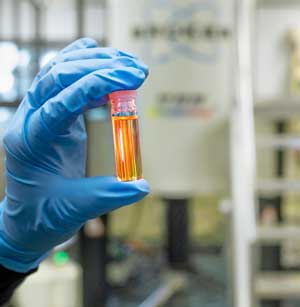 New research provides insight into the structure of silicon nanocrystals, a substance that promises to provide efficient lithium ion batteries that power your phone to medical imaging on the nanoscale.
New research provides insight into the structure of silicon nanocrystals, a substance that promises to provide efficient lithium ion batteries that power your phone to medical imaging on the nanoscale.
Thursday, June 6, 2019
Understanding the (ultra-small) structure of silicon nanocrystals
 New research provides insight into the structure of silicon nanocrystals, a substance that promises to provide efficient lithium ion batteries that power your phone to medical imaging on the nanoscale.
New research provides insight into the structure of silicon nanocrystals, a substance that promises to provide efficient lithium ion batteries that power your phone to medical imaging on the nanoscale.
Scientists create new class of two-dimensional materials
 Fabrication of ultrathin perovskite oxides down to the monolayer limit could help unlock new quantum computing and energy technologies.
Fabrication of ultrathin perovskite oxides down to the monolayer limit could help unlock new quantum computing and energy technologies.
2D nanomaterial reverse osmosis membrane for water desalination
 The exfoliated layered MoS2 nanosheets have a thickness of ca. 2.2 nm with 2-3 layers and highly negatively charged properties.
The exfoliated layered MoS2 nanosheets have a thickness of ca. 2.2 nm with 2-3 layers and highly negatively charged properties.
New molecular sieves
 An international team of researchers recently synthesized polyarylether-based covalent organic frameworks, the most stable crystalline porous material on record.
An international team of researchers recently synthesized polyarylether-based covalent organic frameworks, the most stable crystalline porous material on record.
3D microchannels promote self-assembly of ordered emulsions at low droplet concentrations
 Researchers have discovered a way to achieve self-assembly of low density droplets in microfluidic flows using three dimensional (3D) microchannels.
Researchers have discovered a way to achieve self-assembly of low density droplets in microfluidic flows using three dimensional (3D) microchannels.
Manipulating 2D material unlocks properties for quantum information storage and computing
 Researchers have come up with a way to manipulate tungsten diselenide - a promising two-dimensional material - to further unlock its potential to enable faster, more efficient computing, and even quantum information processing and storage.
Researchers have come up with a way to manipulate tungsten diselenide - a promising two-dimensional material - to further unlock its potential to enable faster, more efficient computing, and even quantum information processing and storage.
Manipulating nanoscale light in nanocavity of scanning tunneling microscope junction
 Manipulating nanoscale light in scanning tunneling microscope junctions is attained by nanofabrication of gold tips using a focused ion beam technique.
Manipulating nanoscale light in scanning tunneling microscope junctions is attained by nanofabrication of gold tips using a focused ion beam technique.
Subscribe to:
Posts (Atom)
